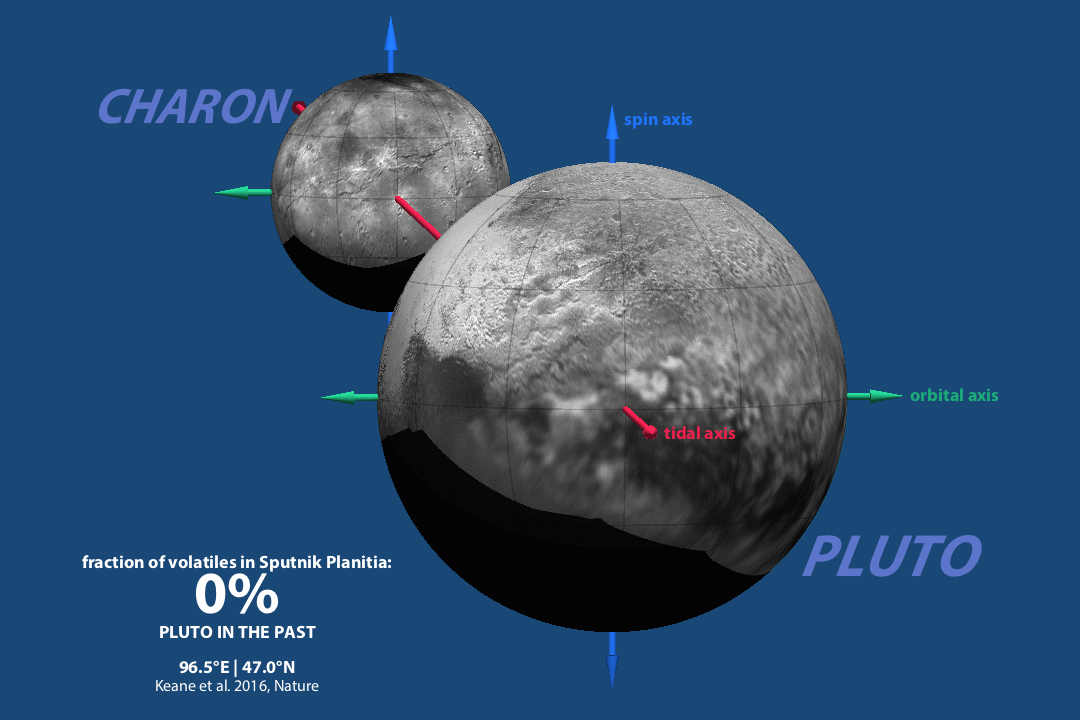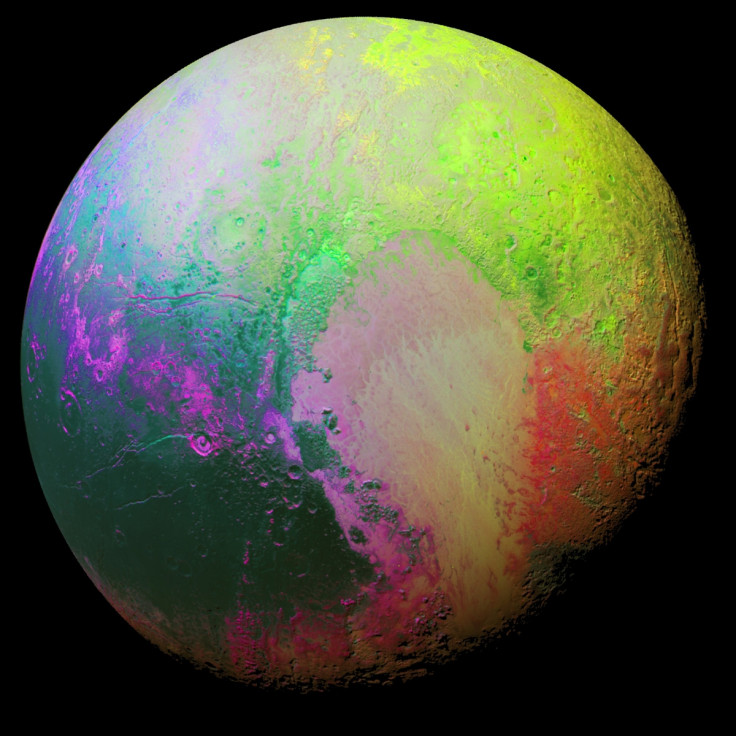Huge underground ocean makes Pluto turn its icy heart away from moon Charon
The slushy ice-water ocean may have caused the dwarf planet to spin into a new alignment.
Sputnik Planitia, a huge basin in the heart-shaped region of Pluto, may be covering a huge subsurface ocean that caused the planet to rotate, stressing the dwarf planet's crust to produce canyons and mountains across its surface. A pair of studies in the journal Nature have analysed data from the New Horizons flyby to investigate the origins and consequences of the basin and the ocean that may lie beneath it.
The studies suggest that the basin is filled with ice and has created cracks and tensions in the dwarf planet's crust. The ice-filled basin made Pluto roll over slightly, the authors say, because adding a great deal of mass to one part of the dwarf planet would make it turn that part closer to its equator.
Mass shifting to the equator
Sputnik Planitia aligns very well with Pluto's tidal axis with its largest moon Charon, suggesting that extra mass of the ice in that location would have affected tidal forces between Pluto and Charon. These forces could have been enough to make Pluto roll over, the authors say. This would leave Pluto in its present position, with its icy heart facing directly away from Charon.
"The New Horizons data say it's not only opposite [from] Charon, but it's really close to being almost exactly opposite," says Richard Binzel of MIT in the US, an investigator on the New Horizons team. "So we asked, what's the chance of that randomly happening? And it's less than 5% that it would be so perfectly opposite. And then the question becomes, what was it that caused this alignment?"

Such is Pluto's weather that each time it orbits the Sun, nitrogen 'snowfall' accumulates in its heart-shaped region, says James Keane of the University of Arizona, author of one of the pair of papers in Nature. "Once enough ice has piled up, maybe 100 metres thick, it starts to overwhelm the planet's shape, which dictates the planet's orientation. And if you have an excess of mass in one spot on the planet, it wants to go to the equator. Eventually, over millions of years, it will drag the whole planet over."
Underground ocean adds weight
However, the basin of ice would not provide enough mass to cause this rotation, says Francis Nimmo of the University of California Santa Cruz, author of the second of the pair of papers. "It's a big, elliptical hole in the ground, so the extra weight must be hiding somewhere beneath the surface," Nimmo says.
In his paper he proposes that an ocean beneath Pluto's surface could provide this mass. Such an ocean has been proposed previously, and Nimmo says that his analysis adds support to the hypothesis. The water may also have an antifreeze agent in it to remain liquid, which Nimmo proposes could be ammonia. Binzel says that the ocean may not be completely liquid but a slushy water-ice mixture.

The reorientation due to this subsurface ocean would have introduced a lot of strain in Pluto's crust, argues Keane in his paper. This strain produced a network of canyons and mountains across the dwarf planet, he says.
Accumulating nitrogen
The origins of the Sputnik Planitia basin in Pluto's heart are thought to be the impact of a giant meteorite that blasted away a chunk of Pluto's crust. An ocean beneath the surface of this area would have meant that water would well up to the impact site and freeze.
"At that point, there is no extra mass at Sputnik Planitia," Nimmo says. "What happens then is the ice shell gets cold and strong, and the basin fills with nitrogen ice. That nitrogen represents the excess mass."
"There's plenty of nitrogen in Pluto's atmosphere, and either it preferentially freezes out in this low basin, or it freezes out in the high areas surrounding the basin and flows down as glaciers," he says. Images from New Horizons indeed appear to show nitrogen glaciers flowing out of mountainous terrain around Sputnik Planitia.

"We tried to think of other ways to get a positive gravity anomaly, and none of them look as likely as a subsurface ocean," he says.
The New Horizons spacecraft flew by Pluto in July 2015 after a nine-year journey. It observed an enormous, pale heart-shaped area on Pluto's surface. Within this heart on the left-hand side is a 1,000-kilometre-wide basin called Sputnik Planitia, which is about the size of the largest basins on Mercury and Mars, Binzel says.
"Pluto is hard to fathom on so many different levels," says New Horizons co-investigator Richard Binzel, professor of Earth, atmospheric and planetary sciences at MIT. Binzel is also a joint professor of aerospace engineering and a faculty affiliate with the MIT Kavli Institute. "People had considered whether you could get a subsurface layer of water somewhere on Pluto. What's surprising is that we would have any information from a flyby that would give a compelling argument as to why there might be a subsurface ocean there. Pluto just continues to surprise us."

© Copyright IBTimes 2025. All rights reserved.






















